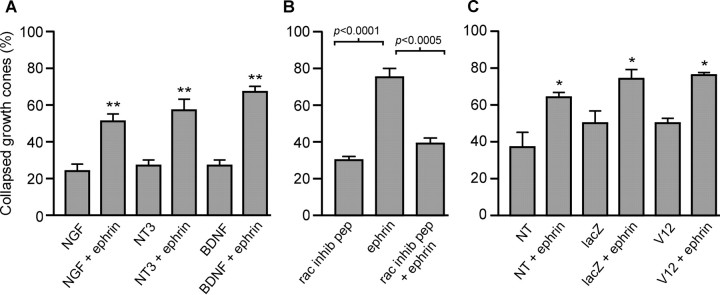Fig. 4.
Inhibition of Rac1 signaling but not expression of constitutively active Rac1 blocks DRG growth cone collapse in response to ephrin-A2. A, Quantification of DRG growth cone response to ephrin-A2. Ephrin-A2 induced growth cone collapse in all culture conditions. E9 lumbrosacral DRG were cultured overnight in NGF, neurotrophin-3 (NT3), or BDNF and then treated with 2.0 μg/ml ephrin-A2 for 15 min. B, Role of Rac1 signaling in ephrin-A2 induced collapse. Inhibition of Rac1 signaling blocked ephrin-induced growth cone collapse. DRG explants were raised in BDNF and then treated with Rac1 inhibitory peptide (rac inhib pep; 1 hr, 2.0 μg/ml) before exposure to ephrin-A2 (15 min, 2.0 μg/ml). C, Role of constitutively active Rac1 in growth cone collapse. Viral infection did not change the percentage of spontaneously collapsed growth cones (p > 0.05). After ephrin-A2 treatment (15 min, 2.0 μg/ml), growth cones collapsed to a similar extent regardless of viral infection. DRG neurons were dissociated and infected with adenovirus engineered to express either constitutively active Rac1 (V12) or lacZ as a control and then cultured for 3 d. Additional control cultures were not infected with viruses (NT). More growth cones were spontaneously collapsed in all groups after 3 d in vitro versus 1 d in vitro. Significant difference form control: *p < 0.05; **p < 0.01.

